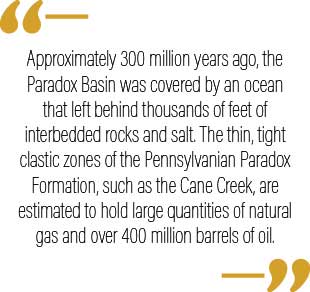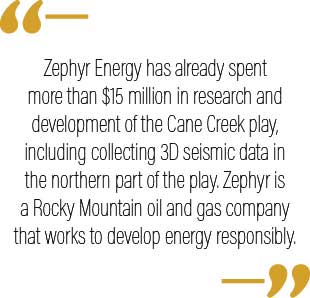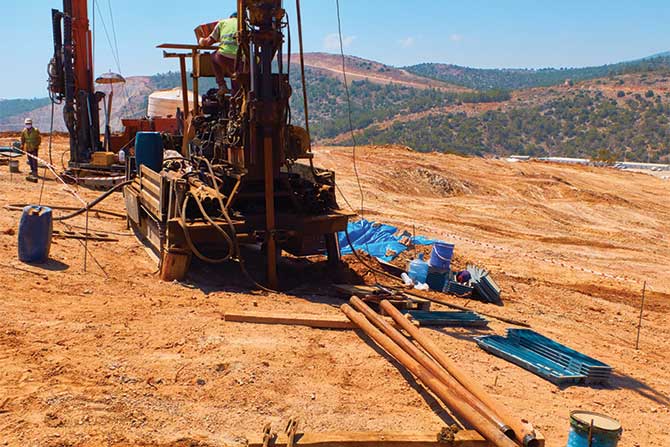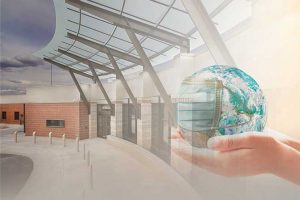By The Utah Petroleum Association
Production from unconventional oil and gas reservoirs has revolutionized the domestic energy landscape and has allowed the U.S. to become the world’s top oil producer. But there’s more research to be done because maximizing oil and gas production from unconventional reservoirs continues to be a challenge.
One example of an under-drilled, unconventional oil play is located in the northern Paradox Basin of southeastern Utah in Grand and San Juan Counties.
Approximately 300 million years ago, the Paradox Basin was covered by an ocean that left behind thousands of feet of interbedded rocks and salt. The thin, tight clastic zones of the Pennsylvanian Paradox Formation, such as the Cane Creek, are estimated to hold large quantities of natural gas and over 400 million barrels of oil.

Although oil and gas companies are interested in this emerging play, current wells often fall short of production expectations due to technological hurdles. Most wells are drilled to intersect natural fractures since the mechanically ductile salt layers above and below the thin reservoirs can mobilize during stimulation, resulting in formation damage that shuts down production.
The current reservoir practices are aimed at locating and drilling perpendicular to these natural fractures. This approach has resulted in some excellent wells, but many more wells are underperforming, and much of the formation remains inaccessible. Furthermore, the stress regime geographically changes along the play area, and ideal well placement is not well understood.
To help solve some of these problems, the U.S. Department of Energy’s Office of Fossil Energy awarded the Energy & Geoscience Institute (EGI) at the University of Utah and the Utah Geological Survey $8 million in federal funding to be spent on a research to better understand this play. The money will be combined with $2 to $3 million in state and private cost-share funds.
According to Dr. Brian McPherson at the University of Utah, the project’s principal investigator, “The northern Paradox unconventional oil play has the potential to be an important economic resource not only for rural Utah but could also further push the United States toward energy independence. Projects such as this one will no doubt provide the catalyst to further the ongoing unconventional oil production transformation.”
Dr. McPherson is a researcher at EGI and an associate professor of Civil and Environmental Engineering. Michael Vanden Berg, Energy and Mineral Program Manager at the Utah Geological Survey, is the geology team lead and co-Principal Investigator of the project.
The project’s leading participants, listed alphabetically, include geologists and engineers from the following:
- Brigham Young University
- Liberty Pioneer Energy Source Inc.
- Par Five Exploration LLC
- Rockies Standard Oil Company LLC
- Statistical Petrophysics LLC
- Utah Geological Survey
- Zephyr Energy (formerly Rose Petroleum PLC)
Zephyr Energy has already spent more than $15 million in research and development of the Cane Creek play, including collecting 3D seismic data in the northern part of the play. Zephyr is a Rocky Mountain oil and gas company that works to develop energy responsibly.

Work still needs to be done to characterize the region’s geology, stress regime, fracture networks and optimal well-completion practices.
Participants will combine innovative borehole image logs with new core data to create discrete fracture network and geomechanical models. The models will help experts predict the occurrence of natural fractures and faults and forecast the efficacy of novel stimulation approaches. All the data will be integrated into coupled numerical models and machine learning algorithms. The team will generate a regional-scale development strategy plan that uses the resulting optimized version, and the plan will be field validated.
Before having an industry partner, the project team (EGI and UGS) selected three potential sites in the play for drilling the research well to match different budget scenarios.
- The southern site was the shallowest and least expensive to drill.
- The northern site was the deepest and most expensive.
- The central site was in between (with respect to depth and cost).
The team preferred to drill the northern site due to the area’s productive potential and the lack of historic geologic data, but it was willing to settle for a cheaper option that would still provide good data. After the team realized that its budget would not support a northern-site drilling, Zephyr stepped in to create a partnership. The partnership creates a win-win situation:
- The team gets to drill in the area that will be most beneficial to understanding this play.
- Zephyr gets geologic data and access to a vertical well on their lease and their 3D survey.
The site has approximately 30 alternating cycles of rock and salt in the Paradox Formation. Each cycle is numbered. The current study will involve drilling a vertical stratigraphic test well targeting the Cane Creek and C18/19 reservoirs while gathering data throughout the effort.
The research group and Zephyr chose the site for several reasons, including the fact that its location is mutually beneficial:
- Zephyr’s experts saw the potential for a natural fracture development that may be more economical than existing unconventional resource plays within the U.S. However, the current plan is to target a spot that does not have fractures in order to reduce drilling risks for the research well.
- This partnership allows Zephyr to gain an increased geologic understanding of the area
- The site is within the 20,000-acre lease holding with a 75% working interest held by Zephyr.
- The quality of the underlying 3D seismic data across most of Zephyr’s position is excellent because it reduces drilling risks.
- An existing well pad on SITLA land offered a favorable surface location, minimizing additional surface disturbance.
The money that has been allocated will fund the well, which Zephyr intends to spud by the end of December 2020. Data from the well will be useful during funding discussions about the Paradox acreage, and spudding the well will be a milestone during the process of continuing farm-in discussions.
The Utah Petroleum Association
This story appears in Pub 2 2020-21 Issue 1 of the UPDATE Magazine.







